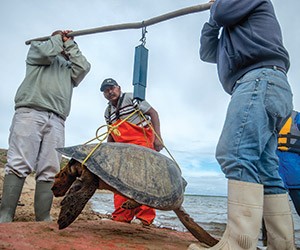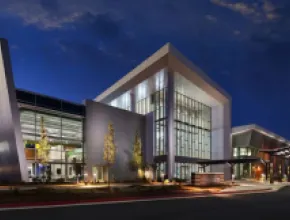“Take nothing but pictures, leave nothing but footprints” is a mantra of green travel that encourages environmental awareness, but many groups today have decided they want to leave something behind in the communities they visit—a positive impact—and local corporate social responsibility (CSR) programs can help them do that.
“Corporate social responsibility and philanthropy are at the core of [our] corporate values,” says Stacey Chiocchio, the CSR project manager for New Hampshire-based Hypertherm, designers and manufacturers of advanced metal cutting systems, which met in January at the Sanibel Harbour Marriott Resort and Spa in Fort Myers.
Chiocchio reached out to United Way to explore ways that attendees could do some community engagement projects during the conference and was connected to Lee County Parks & Recreation Volunteer Services, which is how 49 Hypertherm associates and four park representatives came to remove more than a ton of debris from the Bunche Beach salt flats, an area once used as a dumping ground but today restored to being a habitat for many ground-nesting birds that are on the threatened and endangered species list.
“Most people are looking to give something back,” says Kathy Cahill, volunteer services coordinator for Lee County Parks and Recreation, citing JCPenney and Bank of America among the corporations that have sought out CSR projects in Broward County. Cahill says in 2008, a group from HSBC Bank sent 415 employees to help clear 30 acres of melaleuca trees, which were orignally planted in South Florida in an attempt to “dry out” the Everglades and today are recognized as a threat to the region’s natural wetlands.
“That was ‘extreme volunteering.’ They wanted to make a big impact,” Cahill says. “But we get all kinds of groups, including some students from the University of Georgia who came down for an alternative spring break.”
For the Birds
With its year-round mild weather and abundant shoreline, Florida is a natural for this type of CSR effort, and groups will find such opportunities everywhere in the Sunshine State. In St. Augustine, for one, the St. Johns County Audubon Society (www.stjohnsaudubon.com) welcomes the help of volunteers to assist in safeguarding its local shorebird population.
“Sometimes there will be hundreds of birds on the beach and people won’t see them because they’re practically invisible. Their nests might be nothing more than little scrapes in the sand,” says Teddy Shuler, the Audubon Society’s shorebird coordinator. “So our volunteers go out to the beach and talk to the tourists and even the locals to show them the birds that are nesting and let them know how rare they are.”
In winter, when things cool off to a degree, Audubon and its volunteers focus on surveys of migratory birds that flock to local beaches to refuel, often after traveling thousands of miles.
“They need to eat and have places to forage where they can fatten up before continuing on,” Shuler says.
The data from such surveys is then entered into Audubon’s fish and wildlife database and other databases, including one maintained by Cornell University. Whether they join for a few hours or an entire day, participants are paired with site coordinators for in-field training to identify and log the various bird species.
“Our chapter is into citizen science,” Shuler says. “We protect birds through science-based advocacy and education.”
At the Seashore
In Northwest Florida, some of the most environmentally sensitive coastal areas are unfortunately under the greatest threat from trash-tossing boaters and visitors.
Known as being the largest tract of protected seashore in the country, Gulf Islands National Seashore (www.nps.gov/guis) stretches 160 miles from Cat Island near Gulfport, Miss., to Okaloosa, Fla., with sparkling blue waters, snow-white beaches and luxuriant coastal marshes in between. Groups of any size can help clean up the debris and trash that accumulates on these pristine beaches fronting Pensacola Bay and the Gulf of Mexico on half-day clean-up excursions, keeping a diary of the type of litter accumulated as they go.
“We’ll accommodate whatever people want to do,” says Beth Caverno, the Seashore’s volunteer coordinator. “The more people, the less time it takes.”
Nearby, restoration of a natural habitat is the goal at Project Greenshores (www.dep.state.fl.us/northwest/ecosys/section/greenshores.htm), a 12-acre salt marsh and seagrass habitat along Pensacola’s Bayfront Parkway created by the Florida Department of Environmental Protection and local partners to boost the local estuarine environment, which is critical to infant marine life that depends on seagrass and oysters to filter pollution and reefs to break up damaging waves. Groups can participate in the whole cycle, from growing seagrass in the lab to actually planting it in the estuary.
Lay of the Land
New to the idea of corporate CSR programs in Northwest Florida is Walton County’s E.O. Wilson Biophilia Center at Nokuse Plantation (www.eowilsoncenter.org), a state-of-the-art environmental facility set within the Longleaf Pine ecosystem, which is native to the county and considered to be the sixth most biodiverse area in the continental U.S.
Before 2011, only students and scientists had access to the enter, but after teaming with the local tourism bureau, Visit South Walton, the Center developed hours for public visitation, says Cricket Johnson, Visit South Walton’s sales coordinator.
“Additionally, in 2011, the center opened its doors to groups,” Johnson says. “So attendees interested in donating their time can now participate in CSR projects.”
The first group to volunteer at Biophilia was the Southeast Tourism Society, which convened at Sandestin Golf and Beach Resort in March 2011. After first hearing a presentation by Stella Davis, wife of Biophilia founder M.C. Davis, delegates were put to work, building a fence, constructing an outdoor puppet stage, cleaning classrooms, painting picnic tables and stuffing brochures.
But the work at Biophilia is far from over.
“We always need help with gardening,” says Christy Scally, director at the center. “We also don’t have a real compost bin, so it would be nice if a group would build one for us.”
CSR tasks can begin or end with some team-building time, touring the center and experiencing its interpretive exhibits or trekking through the forest via an extensive trail system winding through the 50,000-acre Nokuse Plantation. In addition, the Biophilia Center is home to a theater with stadium seating as well as several smaller rooms used for eduational breakout sessions.
Cultural Preservation
Florida’s many nature-based CSR opportunities are complemented by a variety of cultural heritage programs as well, including a fascinating option offered by Pensacola’s Florida Public Archaeology Network (FPAN) (www.flpublicarchaeology.org) a statewide organization with a Northwest operation that is affiliated with the University of West Florida.
“We are a working archaeology lab that’s open to volunteers,” explains Irina Sorset, outreach coordinator for the organization. “As archaeologists and anthropologists, we’re interested in past people and cultures and in what people have left behind in the ground and underwater.”
To that end, there may be some digging involved in your group’s adventure through history, but the bulk of the time will likely be spent in the lab, helping to sort artifacts recovered from local archaeological sites.
“You’ll be sitting down, working with screens, trays and brushes, but there’s always an archaeologist working with you,” Sorset says. “For every hour we’re outside digging, we’re in the lab four hours.”
Sorset notes that the lab can fit about 15 people at a time and welcomes volunteer participation Tuesday and Wednesday from 10 a.m. to 4 p.m.
Before or after lab time, groups are invited to visit the on-site museum, Destination Archaeology, which is right across the hallway.
“It’s a road trip through Florida archaeology, but without having to spend days in the car,” Sorset says.
Keeping it Clean
The central and southern regions of the state have a similar variety of CSR programs that allow attendees to roll up their sleeves and put in a few hours of environmentally friendly labor.
South of Daytona Beach at the Ponce Inlet, the Marine Science Center (www.marinesciencecenter.com) receives and cares for thousands of injured and sick sea turtles every year in a “Turtle ER” that visitors can view through large glass windows. The turtle rehab center also treats freshwater turtles and land tortoises, while the on-site Mary Keller Seabird Rehabilitation Sanctuary concentrates on injured and sick birds. The birds and other animals that recover are released back into the wild, while others, either too injured or too tame to make it in the wild, stay at the center and become part of educational programs and guest viewing areas.
The Marine Science Center offers a number of volunteer programs, including animal care and aquarium maintenance, but as some of these require extensive training, most groups help out by keeping the surrounding wetlands and beaches clean. Though at first glance they appear to be tidy, once you start looking, it’s amazing how much debris is hiding among the seaside dunes. In one hour, a recent group attending the Visit Florida-sponsored Florida Encounter conference at Daytona Beach’s Ocean Center filled several trash bags.
In Orlando, Habitat for Humanity (www.habitat.org) benefitted from the skill and expertise of True Value Hardware store owners, retailers and exhibitors attending a recent convention.
“We volunteer with Habitat everywhere we go,” says Susan Katz, director of corporate events and travel for the Chicago-based True Value Company. “This year, they were building a new set of townhomes, putting down decking, cutting boards and hammering. We were able to donate the power tools we used.”
In addition, Katz says that Habitat for Humanity packed and loaded 17 trailers full of product donated by the exhibitors.
South of Daytona, the Broward County Parks and Recreation Division (www.broward.org/parks) coordinates a number of CSR programs at local parks, including the Anne Kolb Nature Center/West Lake Park, Hollywood North Beach, the Fern Forest Nature Center and Secret Woods Nature Centers, Deerfield Island Park, Long Key Nature Center, Tree Tops Park and many others in or near Greater Fort Lauderdale. Duties may include beach clean-up and clearing natural areas of trash and invasive plants, the latter involving removal of exotic vegetation and the planting of native vegetation. Park volunteers also can participate in mountain bike trail maintenance by helping with trail rebuilding, vegetation and erosion control and trail clean-up.
Spanning South Florida’s midsection from Miami to Naples, Everglades National Park (www.nps.gov/ever) is the country’s largest subtropical wilderness, and though it has some lofty distinctions—World Heritage Site, International Biosphere Reserve and Wetland of International Importance—the Everglades is a fragile environment that shelters rare and extraordinarily beautiful bird, animal and plant life while being under constant threat from surging populations.
Volunteer projects here are designed to enhance park trails, facilities and habitats, so your group may pitch in with spring, fall or winter clean-up, trimming vegetation, removing invasive plant species or helping out with such necessary tasks as painting the park’s visitor centers. You might even move “mountains” —that is, the mountains of recycling generated at the recycling center by people who visit and work in the Everglades. They accumulate so quickly, extra hands are often needed at the center to sort, crush and bale recycled cans, glass and cardboard.






